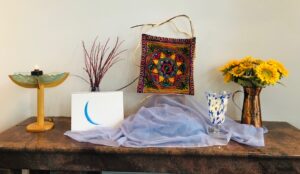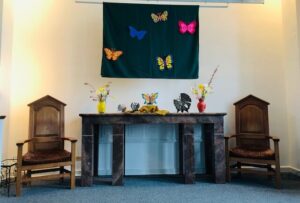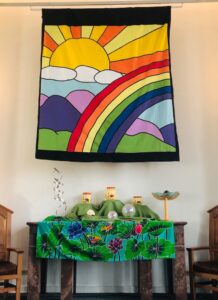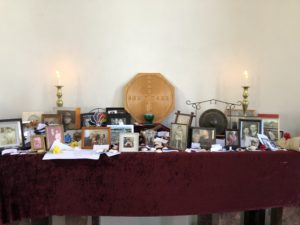“A River of Racism and Privilege: Building Equity Into Health Care”
Dr. Greg Townsend and Rev. Tim Temerson
April 14, 2024
The American health care system is riddled with inequality, inequity, and enormous racial disparities. Today’s service will examine racism in medicine and ask what we as individuals, a church community, and society can do to build a world in which all people have the opportunity to attain their highest level of health. The service will be followed by a conversation about racism and health equity.
Sermon
Good morning, everyone. I want to thank Rev. Tim for allowing/requesting/browbeating me into speaking with you this morning. We rightfully consider ourselves a congregation that is dedicated to loving kindness, and one that wants to be the change that we want to see in the world. But it’s hard to be that change if you don’t know what needs to be changed. I was talking with Chris Little the other day about the Long Range plan, and he said that a GPS can’t tell you how to get to where you want to go unless it knows where you are. To that end, I’m going to shed a little light on where we are.
A while back, I stood up here and talked about the ocean of privilege and the river of racism, and how I need to focus my attention as a health care provider on addressing those issues. This morning I want to invite you to join me in swimming upstream, swimming against the tide. I’m going to talk about health equity, defined by the CDC as “the state in which everyone has a fair and just opportunity to attain their highest level of health”. I’m going to focus on equity as it relates to race and ethnicity, but it’s crucial to keep in mind that there are health equity issues related to many social, economic, demographic and geographic dimensions, such as age, sex, gender, sexual orientation, and disability, and that often these dimensions intersect with multiplicative rather than additive effects.
I’m going to start with a story, which comes from our younger son Damon, who is a resident in Plastic Surgery. Damon often takes call from the Pediatric ER, and always insists that if he is going to need to perform a procedure on a child under the age of 12, that child needs to be sedated. He noticed over the course of several months that he would often get some resistance from the ER docs when he asked them to sedate a child, but that they would more readily relent if the child were White vs Black or Latinx. It all culminated recently when he was called in to perform a procedure on a 7-year-old Black child. When he asked the ER to sedate the child, they declined, saying that the child didn’t need it because he was stoic. When Damon arrived, he found that this child wasn’t stoic, he was in shock. When he again asked the ER docs to sedate the child, they refused. With the help of the child’s attentive and loving mother, Damon was able to anesthetize the child’s hand, but not without some difficulty. Did I mention that the child was Black? Appalled at his experience, Damon then researched whether this was a pattern in this ER, and found that Black children were 60% less likely to receive sedation for the same problems and procedures than were White children.
This is not an isolated phenomenon. This is a pattern that has been documented in scores of research articles from around the country, demonstrating that Black and Latinx patients receive inferior care compared with White patients. But the problem goes much deeper than the health care that people receive. It is an issue of the long-lasting and far-reaching legacy of racism in this country and its impact on the health of people of color.
I promised Rev. Tim that I wouldn’t show too many graphs or charts, which is my usual style, but I want to share a couple with you. Rachel, can you show the first slide? Thanks. This is a map of census districts in Charlottesville, with 2 neighboring districts highlighted. The life expectancy difference between these 2 districts is almost 9 years, despite their proximity. And as you can see by the charts at the bottom, there is a much greater percentage of persons of color in the district with the lower life expectancy, 48% vs 8%. The next slide, please, Rachel? In case you county folks are feeling smug, here’s a map of Albemarle County census districts, and here there is a 10 year difference in life expectancy between 2 districts, with again a huge differential in racial representation in these districts, 13% vs 0%. This pattern also plays out across the country. Among the 500 largest U.S. cities, 56 have life expectancy gaps between census tracts of at least 20 years, with some over 30 years. The largest life expectancy gaps occur most frequently in cities that have the highest levels of racial and ethnic segregation, which is to a great extent a residual of federally implemented neighborhood redlining.
We have known for decades that significant differences in health related to race and ethnicity exist across just about every health domain that you can think of, and that POC receive fewer interventions than do White patients in just about every health domain that you can think of. And people are constantly scratching their heads about why this is. Rachel, next slide please. This is why – it’s racism. But that begs the question, “why is it racism?”. Rachel, can you put up the next slide please? I recognize that this is a complicated graphic, which I’m not going to try to unpack in the time we have. And the reason that it’s so busy is because racism touches every aspect of human life in this country, across the lifespan and across institutional levels.
Generally speaking, health inequities are caused by multilevel systemic mechanisms that distribute power and resources differently across lines of race, gender, class, sexual orientation, gender expression, and other dimensions of individual and group identify. This unequal and unjust allocation of power and resources rears its head in unequal social, economic, and environmental conditions, the social determinants of health. (Rachel end slide show)
I ran across a quote several years ago by the Reverend Martin Luther King, Jr., and it read: “Of all the forms of inequality, injustice in health care is the most shocking and inhumane.” That is a very powerful statement coming from Dr. King, who had heard about, witnessed, and experienced more than his share of inequality. But I learned recently that the quote as I learned it is both inaccurate and incomplete. What King actually said, in 1966 to the Medical Committee for Human Rights, was “Of all the forms of inequality, injustice in health is the most shocking and the most inhuman because it often results in physical death.” Why does that matter? Because “health care”, in the quote as I first heard it, is a comment on how people interact with a health care system, whereas “health”, from the actual quote, is a reflection of how all of society impacts a person’s wellbeing. Because “inhumane”, from the incorrect quote, suggests a lack of compassion for human suffering, whereas “inhuman” suggests a condition that is so cruel that it is not suitable for humans and inhospitable for human life. And because it is important that Dr. King recognized that the consequence of injustice in health is the ultimate consequence, which is to say, death.
Earlier Rev. Tim and I read excerpts from Maya Angelou’s compelling poem “Equality”. I wanted to say a few words about the concepts of equality and equity. Rachel, next slide please. Some of you may have seen this graphic representation of “equality” vs “equity”, making the point that, whereas equality means giving everyone the same resources, equity means giving everyone what they need to succeed. While I appreciate the effort to make this distinction in an easily understandable way, I always had a problem with this graphic, because it suggests that the sole reason that some people are disadvantaged is because of something inherent in them, which may be true in some cases. I prefer something like this – Rachel? This makes the point that, even where people are seemingly equal, they may not have equal opportunities because of the way that society treats them, which is why equity and justice are so important.
It is estimated that between 1999 and 2020, Black Americans experienced more than 1.6 million excess deaths compared to white Americans, representing more than 80 million years of potential life lost; COVID made this even worse. It is also estimated that racial health inequities cost the US more than $400 billion in 2018, a number that it is estimated may balloon to 1 trillion dollars by 2040. This is a public health emergency that affects all of us. And that’s where we come in, as individuals and as a congregation. Because we can be the change we want to see in the world, if we choose to recognize where we are, where we want to be, and what we need to do to get from here to there.
It would be natural to think that this problem is too large for us to be able to impact it. But we don’t have to start with fixing a 1 trillion dollar problem. We can all learn about implicit bias and how to fight it in ourselves and in our society. We can begin to or continue to educate ourselves on where the problems lie in our spheres of influence. Then we can look around and see what we can do, for 1 person, for 1 household, for 1 neighborhood, for 1 school, for 1 community. We can commit to helping marginalized individuals get the care they need, driving them to health care appointments or the pharmacy. We can think about how we can contribute to addressing issues of home improvement, transportation, community health programs, housing supports, resource assistance, and other services that address social determinants of health. If you’re in education, you can work on ways to guarantee access to high-quality early childhood education, support disciplinary policies that minimize expulsions, promote opportunities to keep high-risk kids in school and help them graduate, support LGBTQ+ needs in schools. If you’re an employer, you can support paid family leave, promote healthy behaviors among your employees, offer training on implicit bias, commit to improve the hiring and retention of workers with disabilities. If you work in housing, you can include community members in decision-making, support zoning regulations that encourage high-density, inclusionary, transit-oriented development, learn about how structural barriers produce segregated neighborhoods. Those of us in health care can adopt new vital signs to screen for the nonmedical factors influencing health like access to food and potential for partner violence, guard against the potential for bias to influence medical care, make sure the elderly, women, and racial/ethnic minorities are adequately represented in clinical trials, understand the effects of adverse childhood experiences and use trauma-informed care. If you like communicating with your elected representatives, write to them about making sure your local government has removed questions about convictions from job applications, about ensuring that non-English speakers can access social services, about increasing minimum wages to the level of a liveable wage.
We all have skin in this game. I invite you to fully participate in making our communities ones in which “everyone has a fair and just opportunity to attain their highest level of health”. Albert Einstein said, “Those who have the privilege to know have the duty to act.” Now you know. Come on in – the water may not be fine, not yet, but we can be the ones to make it so. Thank you.
Order of Service
Prelude Deep River
Welcome Rev. Tim Temerson
Achsah Carrier, Board Member
Call to Worship
Chalice Lighting
Hymn #128 For All that Is Our Life
Time For All Ages “How to Be An Upstander to Racism”
Hymn 414 As We Leave This Friendly Place
Chorale Anthem
Centering and Sharing
Ritual of Joys and Sorrows Bob Brett, Pastoral Care Team
Musical Meditation
Offertory
Reading “Equality” by Maya Angelou
Sermon “A River of Racism and Privilege” Greg Townsend
Hymn #149 “Lift Every Voice and Sing” (Performed by Alicia Keys)
Benediction
Chalice Extinguishing
Postlude “Black Like Me” by Mickey Guyton












